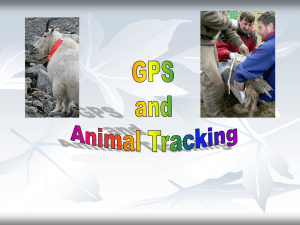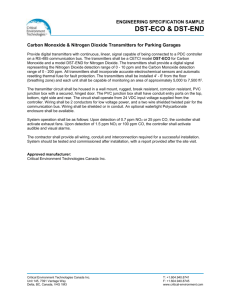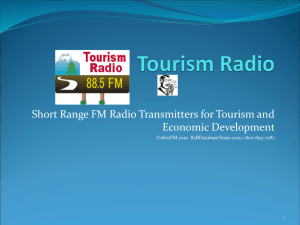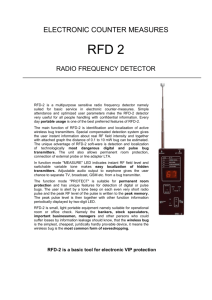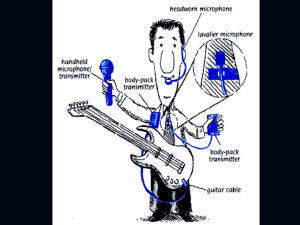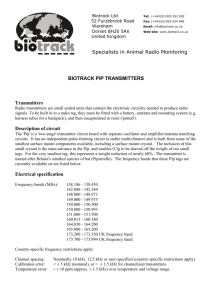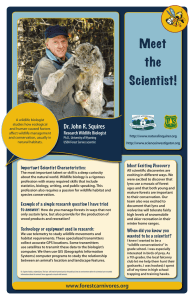Comparison of the Effects and Performance of Four Peer Reviewed
advertisement
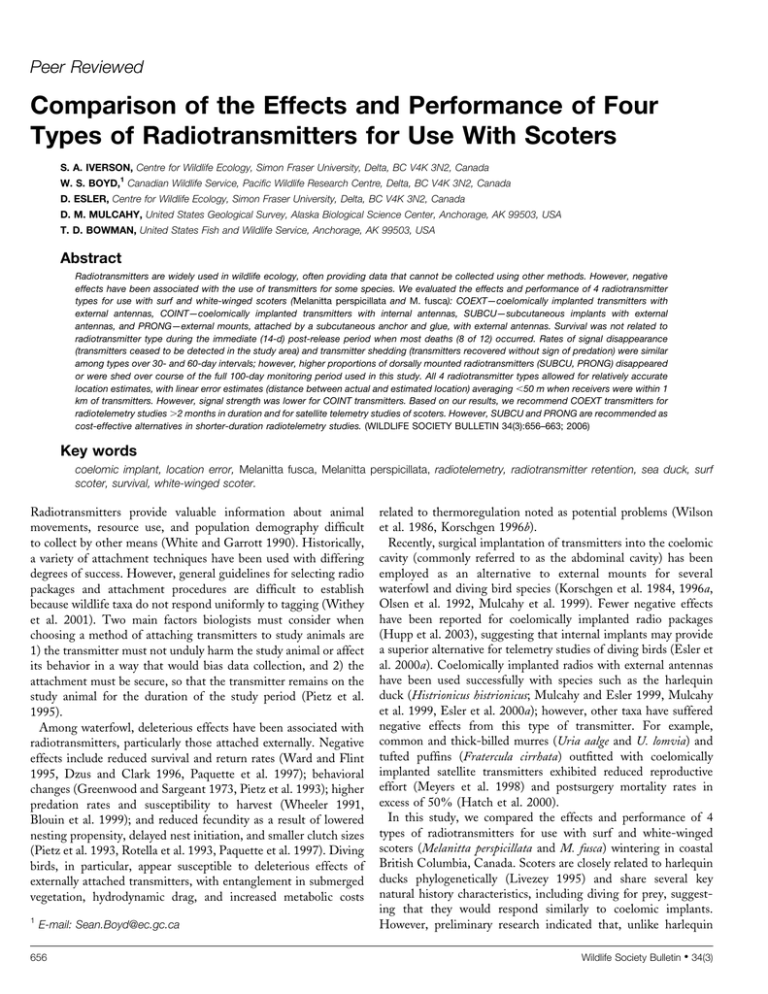
Peer Reviewed Comparison of the Effects and Performance of Four Types of Radiotransmitters for Use With Scoters S. A. IVERSON, Centre for Wildlife Ecology, Simon Fraser University, Delta, BC V4K 3N2, Canada W. S. BOYD,1 Canadian Wildlife Service, Pacific Wildlife Research Centre, Delta, BC V4K 3N2, Canada D. ESLER, Centre for Wildlife Ecology, Simon Fraser University, Delta, BC V4K 3N2, Canada D. M. MULCAHY, United States Geological Survey, Alaska Biological Science Center, Anchorage, AK 99503, USA T. D. BOWMAN, United States Fish and Wildlife Service, Anchorage, AK 99503, USA Abstract Radiotransmitters are widely used in wildlife ecology, often providing data that cannot be collected using other methods. However, negative effects have been associated with the use of transmitters for some species. We evaluated the effects and performance of 4 radiotransmitter types for use with surf and white-winged scoters (Melanitta perspicillata and M. fusca): COEXT—coelomically implanted transmitters with external antennas, COINT—coelomically implanted transmitters with internal antennas, SUBCU—subcutaneous implants with external antennas, and PRONG—external mounts, attached by a subcutaneous anchor and glue, with external antennas. Survival was not related to radiotransmitter type during the immediate (14-d) post-release period when most deaths (8 of 12) occurred. Rates of signal disappearance (transmitters ceased to be detected in the study area) and transmitter shedding (transmitters recovered without sign of predation) were similar among types over 30- and 60-day intervals; however, higher proportions of dorsally mounted radiotransmitters (SUBCU, PRONG) disappeared or were shed over course of the full 100-day monitoring period used in this study. All 4 radiotransmitter types allowed for relatively accurate location estimates, with linear error estimates (distance between actual and estimated location) averaging ,50 m when receivers were within 1 km of transmitters. However, signal strength was lower for COINT transmitters. Based on our results, we recommend COEXT transmitters for radiotelemetry studies .2 months in duration and for satellite telemetry studies of scoters. However, SUBCU and PRONG are recommended as cost-effective alternatives in shorter-duration radiotelemetry studies. (WILDLIFE SOCIETY BULLETIN 34(3):656–663; 2006) Key words coelomic implant, location error, Melanitta fusca, Melanitta perspicillata, radiotelemetry, radiotransmitter retention, sea duck, surf scoter, survival, white-winged scoter. Radiotransmitters provide valuable information about animal movements, resource use, and population demography difficult to collect by other means (White and Garrott 1990). Historically, a variety of attachment techniques have been used with differing degrees of success. However, general guidelines for selecting radio packages and attachment procedures are difficult to establish because wildlife taxa do not respond uniformly to tagging (Withey et al. 2001). Two main factors biologists must consider when choosing a method of attaching transmitters to study animals are 1) the transmitter must not unduly harm the study animal or affect its behavior in a way that would bias data collection, and 2) the attachment must be secure, so that the transmitter remains on the study animal for the duration of the study period (Pietz et al. 1995). Among waterfowl, deleterious effects have been associated with radiotransmitters, particularly those attached externally. Negative effects include reduced survival and return rates (Ward and Flint 1995, Dzus and Clark 1996, Paquette et al. 1997); behavioral changes (Greenwood and Sargeant 1973, Pietz et al. 1993); higher predation rates and susceptibility to harvest (Wheeler 1991, Blouin et al. 1999); and reduced fecundity as a result of lowered nesting propensity, delayed nest initiation, and smaller clutch sizes (Pietz et al. 1993, Rotella et al. 1993, Paquette et al. 1997). Diving birds, in particular, appear susceptible to deleterious effects of externally attached transmitters, with entanglement in submerged vegetation, hydrodynamic drag, and increased metabolic costs 1 E-mail: Sean.Boyd@ec.gc.ca 656 related to thermoregulation noted as potential problems (Wilson et al. 1986, Korschgen 1996b). Recently, surgical implantation of transmitters into the coelomic cavity (commonly referred to as the abdominal cavity) has been employed as an alternative to external mounts for several waterfowl and diving bird species (Korschgen et al. 1984, 1996a, Olsen et al. 1992, Mulcahy et al. 1999). Fewer negative effects have been reported for coelomically implanted radio packages (Hupp et al. 2003), suggesting that internal implants may provide a superior alternative for telemetry studies of diving birds (Esler et al. 2000a). Coelomically implanted radios with external antennas have been used successfully with species such as the harlequin duck (Histrionicus histrionicus; Mulcahy and Esler 1999, Mulcahy et al. 1999, Esler et al. 2000a); however, other taxa have suffered negative effects from this type of transmitter. For example, common and thick-billed murres (Uria aalge and U. lomvia) and tufted puffins (Fratercula cirrhata) outfitted with coelomically implanted satellite transmitters exhibited reduced reproductive effort (Meyers et al. 1998) and postsurgery mortality rates in excess of 50% (Hatch et al. 2000). In this study, we compared the effects and performance of 4 types of radiotransmitters for use with surf and white-winged scoters (Melanitta perspicillata and M. fusca) wintering in coastal British Columbia, Canada. Scoters are closely related to harlequin ducks phylogenetically (Livezey 1995) and share several key natural history characteristics, including diving for prey, suggesting that they would respond similarly to coelomic implants. However, preliminary research indicated that, unlike harlequin Wildlife Society Bulletin 34(3) Figure 1. Four radiotransmitter types used with scoters in coastal British Columbia, Canada, during winter 2001–2002: (a) coelomic implant with external antenna; (b) coelomic implant with coiled internal antenna; (c) dorsal subcutaneous implants with external antenna; (d) external dorsal mount with subcutaneous prong and glue, with external antenna. ducks, scoters experienced high rates of mortality soon after release when implanted with coelomic transmitters (Rosenberg and Petrula 2000). The 4 radiotransmitter types we evaluated in this study were 1) coelomic implants with external antennas, 2) coelomic implants with internal antennas, 3) subcutaneous mounts, and 4) external mounts attached using a subcutaneous prong, with the transmitter also glued to the feathers (Fig. 1). We wanted to evaluate which radiotransmitter types were best suited for studying winter foraging behavior, resource use, and demography of scoters, and for use in satellite telemetry studies. Ideally, comparisons would be made between instrumented and noninstrumented birds, but scoters are extremely difficult to study in the wild; therefore, such an approach was not possible. Our selection of radiotransmitter types allowed us to evaluate factors such as whether surgery is required for attachment; whether the transmitter is placed within the coelomic cavity, subcutaneously, or mounted externally; and whether an external antenna is present. We used 3 sets of criteria to assess transmitter effects and performance: 1) mortality rate of instrumented birds, 2) disappearance of signals due to radiotransmitter failure or shedding, and 3) signal strength and minimization of location error. Methods Capture, Handling, and Transmitter Attachment We captured 100 scoters (42 surf and 58 white-winged scoters) in Baynes Sound, British Columbia, Canada (49832 0 N, 124848 0 W), between 10 and 20 December 2001, using floating mist nets (Kaiser et al. 1995). Once captured, birds were transported by boat to our field station for processing. Each bird was banded with a unique U.S. Fish and Wildlife Service steel leg band. Species and Iverson et al. Radiotransmitter Attachment on Scoters sex were determined using plumage characteristics. Age was determined by probing bursal depth and examining tail-feathers for notches (Iverson et al. 2003). Our study design called for attachment of 40 coelomic implants with external whip antennas (COEXT: 18 g; Holohil Systems, Ltd., Carp, Ontario, Canada), 20 coelomic implants with coiled internal antennas (COINT: 17 g; Advanced Telemetry Systems [ATS], Isanti, Minnesota), 20 subcutaneous implants mounted dorsally with external antennas (SUBCU: 10 g; ATS), and 20 transmitters attached dorsally with a subcutaneous anchor and glued to the feathers, which had external antennas (PRONG: 6 g; ATS). Treatment assignments were made independently for each species, sex, and age combination, resulting in roughly equal species, sex, and age ratios for each treatment. Coelomically implanted radiotransmitters (COEXT, COINT) were attached to scoters using surgical procedures described by Korschgen et al. (1996a) and Mulcahy and Esler (1999). Attachment methods for SUBCU radiotransmitters were first described by Korschgen et al. (1996b), and methods for PRONG radiotransmitters by Mauser and Jarvis (1991) and Pietz et al. (1995). To reduce motion within the airsac, COEXT and COINT transmitters were wrapped in 16-mm nylon mesh and attached using 100% silicone adhesive. To reduce motion underneath the skin, SUBCU transmitters were affixed with sufficient mesh to cover the bottom surface. All birds were anesthetized with 4–5% isoflurane (AerraneTM, Ohmeda, Liberty Corner, New Jersey) in 100% oxygen. The isoflurane was delivered from a precision vaporizer via a modified avian Jackson Rees anesthesia circuit to a facemask while the bird was restrained in ventral recumbency. Birds receiving COEXT or COINT transmitters were intubated with 2.0- or 2.5-mm uncuffed endotracheal tubes; birds receiving SUBCU or PRONG transmitters were maintained on the mask. A surgical depth of anesthesia was maintained at 1.5–3.0% isoflurane as required by the individual bird. All transmitters were sterilized with ethylene oxide gas before use. A separate set of sterilized surgical instruments were used for each surgery, and aseptic techniques were followed. Surgical sites were prepared by clearing the feathers away from the site, disinfecting the skin, and placing a sterile drape over the bird. Coelomically implanted transmitters were placed through a ventral midline incision into the right abdominal airsac. SUBCU transmitters were placed in the area immediately rostral to the scapulae through a dorsal midline incision. The anchor of PRONG transmitters was threaded through a hole made with the point of a sterile #11 scalpel blade. Incisions were closed in a single layer using a simple continuous pattern of 3–0 polyglactin 910 absorbable sutures (VicrylTM, Ethicon, Somerville, New Jersey) with an FS-2 cutting needle. The percutaneous antennas of the COEXT transmitters were secured using a single interrupted knot of the same suture material. Following surgery, the anesthetic was discontinued, and the birds were allowed to recover breathing pure oxygen. When the birds could maintain their heads erect without assistance, they were returned to individual pet carriers for at least 1 hour before being released. All birds were handled in a safe and humane manner, in accordance with approved use protocols by the Animal Care 657 Committee at the University of British Columbia, Canada (Protocol #A01–0227). Radiotransmitter Tracking After release, radiotagged scoters were monitored daily for a 30day period, and thereafter, at weekly intervals from 14 January to 31 March 2002. Mortality status, location, and radiotransmitter signal strength were documented using 2 motor vehicles equipped with 4-element dual-Yagi antennas and null-peak systems. Each transmitter was equipped with a motion-sensitive mortality sensor that doubled pulse rate if inactive for .12 hours. Indicated mortalities were confirmed either by recovery of the carcass or location of the signal in upland habitats, which scoters do not use during the nonbreeding season. Monitoring of radiotransmitters for which signals were lost continued throughout the 100-day study period. Survey protocol was to scan for all frequencies, with telemetry vehicles leap-frogging between roadside pullouts every 1–4 km as necessary to ensure complete coverage of the ;100-km2 study area. Following detection of a transmitter, observers rated signal strength on a scale of 1 to 5, with 1 ¼ very faint; 2 ¼ faint; 3 ¼ moderate; 4 ¼ strong; and 5 ¼ very strong. Locations were determined based on the intersection of signal bearings, using the best biangulation procedure in program LOAS (Ecological Software Solutions 2004). Estimated positions and associated error polygons were determined using fixed bearing standard deviation. All location information for an individual was collected within a 15-minute period to minimize the probability of a bird changing location during data collection. Additionally, field trials were conducted with test transmitters to determine the range of detection, precision, and accuracy of location estimates for each of the 4 radiotransmitter types. A range test was performed by placing test transmitters at the water’s edge and determining signal strength at unobstructed distances of 100 m, 500 m, 1 km, and at 1-km intervals thereafter to a maximum distance of 10 km, from transmitter to receiver. To determine the magnitude of location error, test transmitters were placed aboard a boat and moved to locations approximately 200 m, 500 m, 1 km, and 2 km offshore from receivers. Researchers aboard the boat selected among distance intervals at random, moving back and forth and side to side so shore-based observers—who faced away from the water—were not aware of their location. For each test, boat-based researchers used a Global Positioning System to record their actual location, while shore-based observers estimated bearings, which were subsequently used to derive location estimates in program LOAS. Statistical Analyses Survival.—The first criteria used to evaluate transmitter effects and performance was survival of radiomarked birds. Generalized linear models (STATSOFT 1995) were used to relate survival probability of scoters during the first 14 days after radiotransmitter attachment to potential explanatory variables. The models had a binomial error distribution—with birds that died coded as 0 and those that survived as 1—and used a logit link function to bound parameter estimates. In the most fully parameterized model, species, sex, age, and radio type were all included as potential explanatory variables. We also considered all possible combina658 tions of these variables (treated as main effects) and a null model, for a total of 16 models in our candidate set. To select the most parsimonious model or models, we used Akaike’s Information Criterion (AIC; Burnham and Anderson 2002). We present DAICc scores and Akaike weights (xi) to elucidate our results, where DAICc is a sample-size-corrected estimate of the difference in model fit between the current model and the best-supported model and xi is the likelihood of a given model, relative to all of the models tested (Burnham and Anderson 2002). Additionally, to determine the relative importance of each explanatory variable within a candidate model set, Akaike weights were summed across all candidate models containing the explanatory variable under consideration, thus providing a parameter likelihood value, Rxi, for each variable. For example, Rxsex would be the summed total of Akaike weights for all 8 models considering sex as a potential predictor of survival probability ([a] sex, [b] radio type, sex, [c] species, sex, [d] sex, age, [e] radio type, species, sex, [f] radio type, sex, age, [g] species, sex, age, and [h] radio type, species, sex, age). Parameter likelihood values were useful for quantifying the level of support for each variable when several models had similar DAICc scores. Signal disappearance and radiotransmitter retention.—The propensity of radiotransmitters of different type to fail or be shed was used as the second set of criteria for evaluating radiotransmitter effects and performance. We used a similar modeling procedure to that described for survival rate to evaluate the frequency with which radio signals either 1) disappeared, which could result from radiotransmitter failure or movement by an instrumented bird outside the study area; or 2) were shed, confirmed by recovery of a radiotransmitter without a carcass or sign of predation. Response variables in both cases were binomial, and the same categorical explanatory variables and candidate model sets were used as described above for the survival analysis. The monitoring period for signal disappearance and radiotransmitter retention-rate comparisons extended from the time of release until 31 March 2002, with radio status 100 days after release used to categorize final fates. In addition to the generalized linear model/AIC analyses, we used the Kaplan-Meier procedure to provide a graphical representation of how survival, signal disappearance, and retention probabilities varied over time for each radiotransmitter type. The Kaplan-Meier estimator is commonly used in telemetry studies, wherein the survival function [S(t)] is used to calculate the probability that an arbitrary animal will survive from the beginning of the study to some specified time t (Pollock et al. 1989, Bunck et al. 1995). We expanded the common usage to evaluate not only the probability of survival, but also of signal disappearance and radiotransmitter retention. Signal strength and location error.—Generalized linear models also were used to relate signal strength and location error to distance from transmitter to receiver for each radio type. Response data were obtained from the shore- and boat-based tests described above. Location error was assessed by comparing the distance between estimated and actual positions (linear error), with regression equations used to evaluate differences in slope among radiotransmitter types. Bearing error—calculated as the difference between estimated and actual bearings—also was Wildlife Society Bulletin 34(3) Table 1. Sample sizes for different radiotransmitter packages used with scoters in coastal British Columbia, Canada, during winter 2001–2002, according to species, sex, and age class. COEXTa COINTa SUBCUa PRONGa Totalb Species Surf White-winged 17 22 6 13 8 11 6 12 37 58 Sex Male Female 25 14 11 8 9 10 9 9 54 41 Age Adult Immature 29 10 13 6 13 6 12 6 67 28 a COEXT—coelomically implanted transmitters with external antennas, COINT—coelomically implanted transmitters with internal antennas, SUBCU—subcutaneous implants with external antennas, and PRONG— external mounts, attached by a subcutaneous anchor and glue, with external antennas. b Four scoters died during surgery and one radio did not function properly, leaving a total of 95 radios to be deployed. estimated, with mean bearing error used to determine whether sampling bias was present, and standard deviation to quantify the consistency of our tracking system (Withey et al. 2001). For both the signal strength and linear error analyses, radio type (categorical) and distance (continuous) were evaluated as potential explanatory variables. Additional models, wherein radio types were grouped according to the presence or absence of an external antenna (Antenna: COEXT, SUBCU, PRONG vs. No-antenna: COINT), and interaction terms for radio type 3 distance and antenna 3 distance, were included in the AIC candidate set. There were 14 competing models in each analysis, with sum of square error estimates used to calculate AICc scores. Results Survival We outfitted 99 scoters with radiotransmitters. One of the COEXT transmitters did not function properly and, therefore, was not deployed. Of the birds that were radioed, 4 died under anesthesia or during recovery from anesthesia (1 COINT, 1 SUBCU, 2 PRONG), leaving 95 to be tracked during the winter period (Table 1). Eight scoters died during the first 14 days after release. During this period, survival probabilities were similar among radiotransmitter types, with 3 COEXT (/ ¼ 0.92 6 0.04 SE), 2 COINT (/ ¼ 0.89 6 0.07), 2 SUBCU (/ ¼ 0.89 6 0.07), and 1 PRONG (/ ¼ 0.94 6 0.06 SE) mortality events recorded (Fig. 2a). Among these, 2 carcasses were recovered with talon marks, suggesting predation or scavenging by an avian predator; 3 were tracked to locations below bald eagle (Haliaeetus leucocephalus) nests; 1 carcass was recovered on the beach without any indication of predation or scavenging, and 2 were tracked to beach locations without finding transmitter or carcass. The last 2 transmitters were both coelomic implants, which we assumed to be mortalities rather than shed transmitters because of the unlikelihood that implants could be shed in ,14 days time. Over the remainder of the study (1 Jan–31 Mar), 4 scoters died, 3 of which were outfitted with PRONG radios and 1 with a Iverson et al. Radiotransmitter Attachment on Scoters Figure 2. Weekly probability that (a) radio-outfitted scoter survived, (b) signal was received, and (c) radiotransmitter was not shed for 4 radiotransmitter types used with scoters in coastal British Columbia, Canada, during winter 2001–2002. COEXT radio (Fig. 2a). All 4 of these transmitters were tracked to upland habitats, suggesting that they were attached to depredated or scavenged carcasses. Survival estimates were more variable among transmitter types by the end of the 100-day study period (COEXT / ¼ 0.89 6 0.06 SE, COINT / ¼ 0.89 6 0.09 SE, SUBCU / ¼ 0.89 6 0.09 SE, PRONG / ¼ 0.73 6 0.17 SE); however, the standard error estimate for PRONG-style radios was particularly large due to the high number censored from the dataset due to radio failure and radio shedding, which resulted in a small sample size of scoters that could be considered in the ‘‘at risk’’ pool when calculating Kaplan-Meier survival probabilities. Radio type was not an important predictor of survival probability 659 Table 2. Akaike scores (DAICc) and weights (xi) of best-supported candidate models explaining differences in survival probability of scoters implanted with 4 radiotransmitter packages in coastal British Columbia, Canada, during winter 2001–2002. Results are given for models with DAICc , 2 and the most fully parameterized model. 14-d survival a b 100-d survival Model K DAICcc Null Species Species, sex Age Sex Species, age Radio type, species, sex, age 1 2 3 2 2 3 7 0 0.11 1.56 1.83 1.92 1.98 9.80 xid a Model Kb DAICcc xid 0.25 0.23 0.11 0.10 0.09 0.09 ,0.01 Species Species, age Null Species, sex Age Radio type, species, sex, age 2 3 1 3 2 7 0 0.67 1.01 1.68 1.67 6.62 0.23 0.16 0.14 0.10 0.10 0.01 a Explanatory variables in generalized linear models from which likelihood ratios and AICc scores were calculated. Number of estimable parameters in the model. c Difference between AICc of the current model vs. the best-supported model. d Relative likelihood of a model among those tested. b during the first 14 days after release or over the course of the full monitoring period. Among the models considered in the 14-day survival probability candidate set, the null model had the lowest AICc score (Table 2). There were 6 models with DAICc , 2, all of which had Akaike weights 0.25, indicating low explanatory value of the considered variables. RxRadioType estimates were 0.05 and 0.12 for 14-day and 100-day survival, respectively. Over the course of the full 100-day study period, the model best fitting the data indicated that species was an important explanatory variable (Table 2), because 8 of the 12 scoters that died were surf scoters. Signal Disappearance and Radio Retention With respect to signal disappearance, relatively high proportions of SUBCU and PRONG transmitters ceased to be detected at some point during the 100-day tracking period, with signal disappearance probability estimates of 0.34 6 0.13 SE and 0.47 6 0.18 SE, respectively (Fig. 2b). Signal disappearance proportions were lower for COEXT and COINT transmitters, with estimates 0.18 6 0.07 SE and 0.05 6 0.06 SE, respectively. Generalized linear model results for signal disappearance were somewhat equivocal. Two of the 3 best-fitting models indicated that radiotransmitter type was an important predictor of signal disappearance. However, the null model also was well supported. Akaike weights for the 3 models that best fit the data ranged from 0.10 to 0.23 (Table 3). RxRadioType was 0.58 in the signal disappearance analysis. Transmitter type was an important predictor of retention time. Five dorsally mounted radiotransmitters were shed over the course of our study, with the probability of being shed at some point during the 100-day tracking period estimated as 0.15 6 0.10 SE for SUBCU and 0.24 6 0.14 SE for PRONG transmitters (Fig. 2c). In contrast, no coelomically implanted transmitters were shed. The 3 PRONG radios that were shed transmitted location data for an average of 63 days (range: 45–89) and the 2 SUBCU radios for 95 days (range: 90–99). In the generalized linear model/ AIC analysis, both models with DAICc ,2 contained radio type as an explanatory variable (Table 3), and RxRadioType was 0.93. Species also was included as an explanatory variable in the highestranking models, because 4 of the 5 instances that radios were shed occurred in surf scoters. Signal Strength and Location Error Range tests indicated that signal strength was markedly lower for COINT radios than for the other 3 radio types. The COINT radios could be heard to a maximum distance of 7.5 km, with signal strength rated as faint at a distance of approximately 2.5 km. In contrast, COEXT, SUBCU, and PRONG could be heard at 10 km and were not rated as faint until approximately 7 km (Fig. 3). The model that best fit the data included both the presence of an external antenna and distance from transmitter to receiver as main effects and was strongly supported with an Akaike weight of 0.63 (Table 4). No other model had a DAICc , 2. Estimates for RxDistance and RxAntenna were 1.00 and 0.83, respectively. Table 3. Akaike scores (DAICc) and weights (xi) of best-supported candidate models explaining differences in signal disappearance and radio retention rates for 4 radiotransmitter packages used with scoters in coastal British Columbia, Canada, during winter 2001–2002. Results are given for models with DAICc ,2, the null model, and the most fully parameterized model. Probability signal disappeared (100-d) Probability radio retained (100-d) Modela Kb DAICcc xid Modela Kb DAICcc xid Radio type Null Radio type, age Radio type, species, sex, age 4 1 5 7 0 0.74 1.71 6.06 0.23 0.16 0.10 ,0.01 Radio type, species Radio type, species, sex Radio type, species, sex, age Null 5 6 7 1 0 1.00 3.15 8.42 0.32 0.20 0.07 ,0.01 a Explanatory variables in generalized linear models from which likelihood ratios and AICc scores were calculated. Number of estimable parameters in the model. c Difference between AICc of the current model vs. the best-supported model. d Relative likelihood of a model among those tested. b 660 Wildlife Society Bulletin 34(3) Figure 3. Relationship between distance from transmitter to receiver and (top) signal strength, and (bottom) linear error for the 4 radiotransmitter packages used with scoters in coastal British Columbia, Canada, during winter 2001– 2002. With respect to linear error, measured as the mean distance between actual and estimated locations, variation among radios was minimal at a distance of 200 m, with estimates ranging from 19.9 m for COINT radios to 21.1 m for SUBCU radios. These differences were more pronounced at greater distances, ranging from 74.6 m for COINT to 93.3 m for SUBCU at a distance of 2 km (Fig. 3). All the best-fitting models for predicting linear error included distance as a significant explanatory variable (Table 4). The interaction term for antenna 3 distance also was supported by the data, suggesting a difference in slope between COINT radios and those with external antenna. Estimates for RxDistance and RxAntenna were 1.00 and 0.59, respectively. Mean bearing error estimates, which are useful as tests of sampling bias and should approach zero when a telemetry system is properly calibrated, were low for all 4 radio types (Table 5). Standard deviations of bearing error, which measure precision, also were small (Table 5). These results suggest our tracking system was consistent and free of bias. Discussion All 4 radiotransmitter types we evaluated performed well for investigating winter movements, foraging ecology, and demogIverson et al. Radiotransmitter Attachment on Scoters raphy of scoters. However, trade-offs were evident among different radiotransmitter types, and the recommendations that follow reflect these trade-offs. The first criterion we investigated and the foremost consideration in any radiotelemetry study is the well being of study animals. Higher mortality rates associated with surgery and during the period immediately following release were hypothesized as one potential disadvantage of using coelomically implanted radiotransmitters on scoters. However, in this study, differences in survival probability between scoters with coelomically implanted (COEXT, COINT) versus dorsally attached (SUBCU, PRONG) radiotransmitters were not evident. Overall, surgery-related and 14-day postrelease mortality rates were 4.0% and 8.4%, respectively. For coelomic implants, these estimates were 1.7% and 8.6%. While higher than those documented for harlequin ducks implanted using methods identical to that described for COEXT transmitters in this paper (1.5% and 1.5%, respectively; Mulcahy and Esler 1999), the mortality rates we observed were much lower than those experienced in earlier studies using coelomically implanted satellite transmitters to track scoter movements in Alaska, where 38.7% of implanted scoters died within the first 14 days after release (n ¼ 31; Rosenberg and Petrula 2000). In our study, all scoters that received radiotransmitters were anesthetized with isoflurane, a procedure not routinely used when attaching PRONG radios. We did this to control effects of anesthesia when evaluating different attachment procedures; however, the possibility that anesthesia may have impacted survival and negated one of the advantages of PRONG transmitters must be considered. Of the 6 PRONG-outfitted scoters that died in this study, 2 did so while under or recovering from anesthesia, 1 during the first 2 weeks after release, and 3 others over the remaining monitoring period. Other studies that have investigated the use of isoflurane to anesthetize waterfowl and diving birds have found that most postsurgery deaths occur shortly after completion of surgery (Mulcahy and Esler 1999). Thus, while it is unlikely that the use of isoflurane played a role in the mortality of PRONG-outfitted scoters .14 days after release, we cannot discount the possibility that such birds experienced higher mortality than otherwise would have been expected during the immediate postsurgery period. It also should be noted that previous work on wintering harlequin ducks has indicated that natural mortality is highest during midwinter (Esler et al. 2000b), and not all postrelease deaths documented in this study were necessarily related to radiotransmitter attachment. Bald eagle densities were high in our study area, and either predation or scavenging of radio-outfitted scoters was evident in 5 of the 8 deaths that occurred during the first 14 days after release. Esler et al. (2000b) censored data collected during the 2 weeks immediately following radiotransmitter attachment to avoid biasing estimates of demographic parameters due to radio effects. Based on our results, a similar data-censoring period appears warranted for scoters, because only 4 of the 12 scoters that died in our study did so more than 2 weeks after attachment. The second set of criteria we used to evaluate transmitter effects and performance was the probability of signal disappearance or 661 Table 4. Akaike scores (DAICc) and weights (xi) of best-supported candidate models explaining differences in signal strength and linear error for 4 radiotransmitter types used with scoters in coastal British Columbia, Canada, during winter 2001–2002. Results given for models with DAICc ,2, the null model, and the most fully parameterized model. Signal strength a Linear error b Model K Antenna, distance Radio type, distance, radio type 3 distance Null 3 8 1 DAICcc xid a Model Kb DAICcc xid 0.00 6.10 105.32 0.63 0.03 ,0.01 Distance Antennae 3 distance Antennae, distance Antennae, distance, antennae 3 distance 2 3 3 4 0.00 0.14 1.87 1.88 0.34 0.32 0.13 0.13 a Explanatory variables in generalized linear models from which likelihood ratios and AICc scores were calculated. Number of estimable parameters in the model. Difference between AICc of the current model vs. the best-supported model. d Relative likelihood of a model among those tested. b c shedding of radiotransmitters. One potential drawback of noncoelomically implanted transmitters—particularly PRONG style—has been their failure to remain on ducks long enough to provide sufficient data when attached only with sutures or sutures and glue (Rotella et al. 1993). Previous studies have found that attaching PRONG radios using subcutaneous anchors and glue— as was done in this study—has eliminated many of these problems. For example, Pietz et al. (1995) reported that 98% (n ¼ 91) of prong-outfitted mallards (Anas platyrhynchos) and gadwalls (A. strepera) retained their transmitters over a 75-day study interval. Retention probabilities for PRONG transmitters were not nearly as high in this study. After 60 days, the retention rate of PRONG-outfitted scoters was 86%, and after 100 days, it was 74%. Two SUBCU radios also were shed after day 90, yielding a 100-day retention probability of 85%. In contrast, no coelomically implanted scoters were known to have shed their transmitters, and although such extrusions have been documented, these occurrences are extremely rare (Garrettson and Rohwer 1996, Mulcahy et al. 1999). With respect to signal disappearance, some variation among radiotransmitter types was evident, with COINT and COEXT transmitters having the lowest signal-disappearance rates and SUBCU and PRONG the highest. Although our study design did not allow us to examine whether dispersal probability was related to radiotransmitter type, we believe the likelihood of such an Table 5. Mean, SE, and SD of estimates for linear and bearing error determined in field tests of 4 radiotransmitter packages used with scoters in coastal British Columbia, Canada, during winter 2001–2002. a b Radio type n COEXT COINT SUBCU PRONG 12 10 14 14 a Linear error (m) _ x SE SD 37.5 32.4 42.9 46.7 10.4 11.4 10.7 12.3 36.0 36.2 40.0 45.8 Bearing error (deg) _ x SE SD 0.2 0.0 1.2 0.9 0.9 1.7 1.4 1.1 3.2 5.5 5.3 4.0 COEXT—coelomically implanted transmitters with external antennas, COINT—coelomically implanted transmitters with internal antennas, SUBCU—subcutaneous implants with external antennas, and PRONG— external mounts, attached by a subcutaneous anchor and glue, with external antennas. b Number of transmitter locations estimated. Two bearings were taken for each sample. 662 association is low. Failure rates also are unlikely to differ dramatically between radiotransmitter types, and we believe the higher rates of signal disappearance for PRONG and SUBCU transmitters on scoters are related to undetected shedding events. Thus, while dorsally implanted packages appear suitable for shorter-term studies, some caution is advised for their use in longer-term studies. The final criterion we investigated, which is particularly important in studies that quantify home-range and habitat-use patterns, was location error. Location estimates often are incorrectly assumed to be accurate and free of bias. However, all animal locations obtained remotely are estimates and, as such, have associated errors that should be estimated (Saltz 1994). Not surprisingly, signal strength was lower for coelomically implanted radiotransmitters with internal antennas than the other 3 radiotransmitter types. The shorter distances over which COINT radios can be detected limits their utility in some studies (Olsen et al. 1992, Boyd et al. 2000) and precludes their use in satellite telemetry studies, wherein external antenna are required. The magnitude of location error was relatively low for all 4 radiotransmitter types evaluated. Location estimates within 1 km generally are thought to be sufficient for studies of long-range migration or dispersal, whereas fine-scale resource selection studies depend upon more precise location estimates (Withey et al. 2001). Based on our results, linear error can be held under 50 m when receivers are within 1 km of radiomarked scoters in open water, a distance attained without difficulty with our tracking protocol. Although many studies have documented negative effects associated with the use of transmitters, it is important to emphasize that many insights we have gained into the behavior of wildlife species would not be possible without telemetry data (Withey et al. 2001). Based on the considerations outlined above, we conclude with the following summary of transmitter effects and performance for the 4 radiotransmitter types evaluated for use with scoters. Prong-style radios have the advantage of not requiring anesthesia or implantation within the coelomic cavity, and they have external antennas, which improves signal strength. However, retention rates tend to be low relative to coelomically implanted radios. Thus, prong transmitters are most appropriate for shorter-duration studies designed for purposes such as locating nests or tracking molt movements. Subcutaneously implanted radiotransmitters offer similar benefits to prong transmitters Wildlife Society Bulletin 34(3) without several of the potential risks, including entanglement with submerged vegetation and increased hydrodynamic drag (Korschgen et al. 1996b). However, subcutaneous transmitters must be implanted using local anesthesia at least, and retention rates are not as high as those attainable using coelomic implants. Coelomically implanted radios performed well in this study. While the surgery process is more invasive than the one required for attaching prong or subcutaneous radios, mortality rates were similar and coelomic implants allow for higher retention and lower signal disappearance rates. Coelomically implanted radios with coiled internal antennas offered no apparent advantage over those with external antennas. Therefore, we recommend coelomic implants with external antennas for studies .2–3 months in duration and for satellite telemetry studies. Acknowledgments We thank G. Grigg, S. Coulter, A. McLean, C. Hall, D. LaCroix, P. Shepard, and S. Cullen for assistance in the field. Literature Cited Blouin, F., J.-F. Giroux, J. Ferron, G. Gauthier, and C. J. Doucet. 1999. The use of satellite telemetry to track greater snow geese. Journal of Field Ornithology 70:187–199. Boyd, W. S., S. D. Schneider, and S. A. Cullen. 2000. Using radiotelemetry to describe the fall migration of eared grebes. Journal of Field Ornithology 71: 702–707. Bunck, C. M., C. L. Chen, and K. H. Pollock. 1995. Robustness of survival estimates from radiotelemetry studies with uncertain relocation of individuals. Journal of Wildlife Management 59:790–794. Burnham, K. P., and D. R. Anderson. 2002. Model selection and multimodel inference: a practical information–theoretic approach. Springer-Verlag, New York, New York, USA. Dzus, E. H., and R. G. Clark. 1996. Effects of harness-style and abdominally implanted transmitters on survival and return rates of mallards. Journal of Field Ornithology 67:549–557. Ecological Software Solutions. 2004. Loas version 3.0.2. Ecological Software Solutions, Sacramento, California, USA. Esler, D., D. M. Mulcahy, and R. L. Jarvis. 2000a. Testing assumptions for unbiased estimation of survival of radiomarked harlequin ducks. Journal of Wildlife Management 64:591–598. Esler, D., J. A. Schmutz, R. L. Jarvis, and D. M. Mulcahy. 2000b. Winter survival of adult female harlequin ducks in relation to history of contamination by the Exxon Valdez oil spill. Journal of Wildlife Management 64:839–847. Garrettson, P. R., and F. C. Rohwer. 1996. Loss of an abdominally implanted transmitter by a wild blue-winged teal. Journal of Field Ornithology 67:355– 357. Greenwood, R. J., and A. B. Sargeant. 1973. Influence of radiopacks on captive mallards and blue-winged teal. Journal of Wildlife Management 37: 3–9. Hatch, S. A., P. M. Meyers, D. M. Mulcahy, and D. C. Douglas. 2000. Performance of implantable satellite transmitters in diving seabirds. Waterbirds 23:84–94. Hupp, J. W., G. A. Ruhl, J. M. Pearce, D. M. Mulcahy, and M. A. Tomeo. 2003. Effects of implanted radiotransmitters with percutaneous antennas on the behavior of Canada geese. Journal of Field Ornithology 74:250–256. Iverson, S. A., D. Esler, and W. S. Boyd. 2003. Plumage characteristics as an indicator of age class in the surf scoter. Waterbirds 26:56–61. Kaiser, G. W., A. E. Derocher, S. C. Crawford, M. J. Gill, and I. A. Manley. 1995. A capture technique for marbled murrelets in coastal inlets. Journal of Field Ornithology 66:321–333. Korschgen, C. E., K. P. Kenow, A. Gendron-Fitzpatrick, W. L. Green, and F. J. Dein. 1996a. Implanting intra-abdominal radiotransmitters with external whip antennas in ducks. Journal of Wildlife Management 60:132–137. Korschgen, C. E., K. P. Kenow, W. L. Green, M. D. Samuel, and L. Sileo. 1996b. Technique for implanting radiotransmitters subcutaneously in dayold ducklings. Journal of Field Ornithology 67:392–397. Korschgen, C. E., S. J. Maxson, and V. B. Kuechle. 1984. Evaluation of implanted radiotransmitters in ducks. Journal of Wildlife Management 48: 982–987. Livezey, B. C. 1995. Phylogeny and evolutionary ecology of modern seaducks (Anatidae: Mergini). Condor 97:233–255. Mauser, D. M., and R. L. Jarvis. 1991. Attaching radiotransmitters on 1-dayold mallard ducklings. Journal of Wildlife Management 55:488–491. Meyers, P. M., S. A. Hatch, and D. M. Mulcahy. 1998. Effect of implanted Iverson et al. Radiotransmitter Attachment on Scoters satellite transmitters on the nesting behavior of murres. Condor 100:172– 174. Mulcahy, D. M., and D. Esler. 1999. Surgical and immediate postrelease mortality of harlequin ducks (Histrionicus histrionicus) implanted with abdominal radiotransmitters with percutaneous antennas. Journal of Zoo and Wildlife Medicine 30:397–401. Mulcahy, D. M., D. Esler, and M. K. Stoskopf. 1999. Loss from harlequin ducks of abdominally implanted radiotransmitters equipped with percutaneous antennas. Journal of Field Ornithology 70:244–250. Olsen, G. H., F. J. Dein, G. M. Haramis, and D. G. Jorde. 1992. Implanting radiotransmitters in wintering canvasbacks. Journal of Wildlife Management 56:325–328. Paquette, G. A., J. H. Devries, R. B. Emery, D. W. Howerter, B. L. Joynt, and T. P. Sankowski. 1997. Effects of transmitters on reproduction and survival of wild mallards. Journal of Wildlife Management 61:953–961. Pietz, P. J., D. A. Brandt, G. L. Krapu, and D. A. Buhl. 1995. Modified transmitter attachment method for adult ducks. Journal of Field Ornithology 66:408–417. Pietz, P. J., G. L. Krapu, R. J. Greenwood, and J. T. Lokemoen. 1993. Effects of harness transmitters on behavior and reproduction of wild mallards. Journal of Wildlife Management 57:696–703. Pollock, K. H., S. R. Winterstein, C. M. Bunck, and P. D. Curtis. 1989. Survival analysis in telemetry studies: the staggered entry design. Journal of Wildlife Management 53:7–15. Rosenberg, D. H., and M. J. Petrula. 2000. Scoter life history and ecology: linking satellite technology with traditional knowledge. Exxon Valdez Oil Spill restoration project annual report. Exxon Valdez Oil Spill Trustee Council, Anchorage, Alaska, USA. Rotella, J. J., D. W. Howerter, T. P. Sankowski, and J. H. Devries. 1993. Nesting effort by wild mallards with 3 types of radiotransmitters. Journal of Wildlife Management 57:690–695. Saltz, D. 1994. Reporting error measures in radio location by triangulation: a review. Journal of Wildlife Management 58:181–184. STATSOFT. 1995. Statistica for Windows. Version 6.1. StatSoft, Tulsa, Oklahoma, USA. Ward, D. H., and P. L. Flint. 1995. Effects of harness-attached transmitters on premigration and reproduction of brant. Journal of Wildlife Management 59: 39–46. Wheeler, W. E. 1991. Suture and glue attachment of radiotransmitters on ducks. Journal of Field Ornithology 62:271–278. White, G. C., and R. A. Garrott. 1990. Analysis of wildlife radiotracking data. Academic, San Diego, California, USA. Wilson, R. P., W. S. Grant, and D. C. Duffy. 1986. Recording devices on freeranging marine animals: does measurement affect foraging performance? Ecology 67:1091–1093. Withey, J. C., T. D. Bloxton, and J. M. Marzluff. 2001. Effects of tagging and location error in wildlife radiotelemetry studies. Pages 43–75 in J. J. Millspaugh and J. M. Marzluff, editors. Radiotracking and animal populations. Academic, San Diego, California, USA. Associate Editor: Eadie. 663
